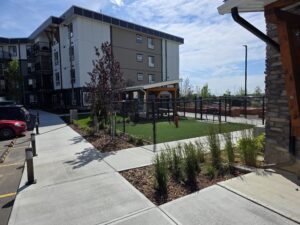A key, but often neglected, issue in the world of commercial landscaping is pest management. Left unchecked, trees, shrubs, and flower beds may harbor parasite or diseases that have the potential to spread. Checking your plants at least twice per season will help protect your property aesthetically, but also against the need to replace your greenery. Below are some of the more common pests and diseases to watch for.
Yellowhead Spruce Sawfly:
The Yellowheaded Spruce Sawfly, is a pest that frequents spruce saplings. The destruction they cause to the needles can reduce plant growth, and eventually kill the tree. Trees should be checked in the early spring for any larvae that may have hatched. To treat an infection, use an insecticide that specifies it is effective against Sawfly larvae.
Black Knot:
Black knot is a very common disease that affects Chokecherry, wild plum trees, ornamental cherry trees, and Mayday trees. In additional to affecting the tree’s appearance, black knot can also lead to the eventual death of the tree. One of the easiest ways to spot black knot is to look for black, tar-like, swelling points on branches. To control the spread of the disease, prune infected branches, preferably to a health collar. This can be done during colder months during the tree’s dormant season.
Dutch Elm Disease:
Dutch Elm disease is a highly infectious fungus that is resistant to treatment. Once an elm tree has been infected, it likely cannot be saved. While there are some instances where the disease can be cut out of the tree, this is rare. The fungus release toxins that spread swiftly to other trees via infected insects. A sure-fire sign that your tree may have been exposed to Elm disease is the sudden yellowing of leaves during the summer.
Since successful treatment is unlikely, proactive measures must be taken, including the removal of any infected elms that could spread the disease to other trees.
Tree Cankers:
Tree Cankers are isolated dead patches on the branches or stem of the tree. They are caused by a fungus that grows between the bark and the wood. Over time, cankers will make the infected tree more vulnerable to infection from other bacteria, fungi and insects. Older trees may weaken and become damaged by wind or cold temperatures. The only way to treat Cankers is using a combination of removing as much of the fungus as possible and applying a fungicide to the infected area.
Want to learn more about protecting the value of your commercial property? Contact GDB today!




